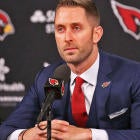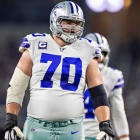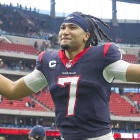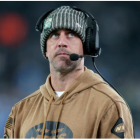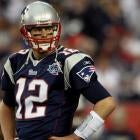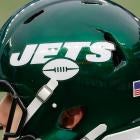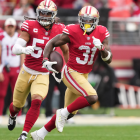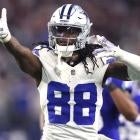The NFC West is going to feature considerably more parity in 2019 than it's had the past two seasons.
The Cardinals' offense will be night and day from where it was last year. The San Francisco 49ers will have a healthy Jimmy Garoppolo and some new pieces out wide and up front on defense. The Seahawks are primed to repeatedly hit big plays down the field and still have plenty of speed on defense. And, of course, the Rams will be a fine-tuned machine on offense and Aaron Donald on defense.
But which club had the best offseason? Who closed the gap the most on the two-time defending division champion Rams?
Here's a breakdown of the entire NFC Wast, with 2019 offseason grades for all four teams.
Grades for all 32 teams can be found right here.
Arizona Cardinals
- Key additions: CB Robert Alford, EDGE Terrell Suggs, ILB Jordan Hicks, OG J.R. Sweezy, DT Darius Philon, TE Charles Clay, RT Marcus Gilbert, OT Desmond Harrison
- Key losses: S Antoine Bethea, EDGE Markus Golden, QB Josh Rosen, S Deone Bucannon, OG Mike Iupati, EDGE Benson Mayowa
- Key rookies: QB Kyler Murray, CB Byron Murphy, WR Andy Isabella, WR Hakeem Butler, EDGE/DL Zach Allen
The Cardinals have gone 100% all-in with Kliff Kingsbury, and I understand why that's being met with some criticism. He's a first-time NFL head coach and didn't have a great record at Texas Tech. You know what he did have though? Awesome offenses. Texas Tech finished in the top 10 in passing yards per game each season he was in Lubbock, and five times placed in the top 25 of scoring offenses nationally.
As the team with the worst record a year ago, Arizona went full bore on the free-agent market, signing a plethora of older-ish, middle-of-the-road veterans like Charles Clay, J.R. Sweezy, Robert Alford, and Marcus Gilbert -- to boost the team's severely lacking depth. Smart. Terrell Suggs still, remarkably, has some juice around the edge, and Darius Philon is a young, ascending interior pass rusher. Desmond Harrison started eight games at left tackle for the Browns in 2018 as a rookie and held his own. He has a fun skill set centered around tremendous athleticism.
Arizona's personnel departures were household names but had either gotten too old, seen their play dip as the team worsened over the past few years, or consistently dealt with injuries.
Oh and then there's Josh Rosen. I'm of the belief moving on from him wasn't an absolute necessity. I get it, though, because of Kingsbury's presence. And as bad as the supporting cast was in Arizona in 2018, Rosen was flat-out bad. Sam Darnold and Josh Allen showed much more than he did -- especially later in the season -- and didn't have outstanding offensive lines or stellar receiver groups either.
Also, Arizona crushed the draft. After Murray, an exquisite fit for Kingsbury's Air Raid, the Cardinals cleaned up. You could see Kingsbury's vision playing a vital role in the team's selections. Awesome YAC and downfield burner Andy Isabella in Round 2 was perfect. Byron Murphy is a zone-specialist playing in Vance Joseph's press man scheme, but he's a playmaker, and the Cardinals only intercepted seven passes last season, which tied for the second-lowest total in football. Hakeem Butler at the start of Round 4 was thievery, as was hybrid rusher Zach Allen later in that round.
I don't know if the Cardinals will take off right away, but they're going to be significantly more fun to watch in 2019 than they were a year ago thanks to the whirlwind of an offseason they pieced together.
Offseason grade: A-
Los Angeles Rams
- Key additions: S Eric Weddle, EDGE/LB Clay Matthews
- Key losses: OG Rodger Saffold, DT Ndamukong Suh, S Lamarcus Joyner, LB Mark Barron
- Key rookies: S Taylor Rapp, RB Darrell Henderson, CB David Long
As the NFC representative in the Super Bowl and team that finished the regular season No. 5 in pass offense DVOA and No. 1 in run offense DVOA, the Rams didn't need to rock the boat in the offseason. And they didn't.
The biggest "addition" in 2019 could very likely be the return of receiver Cooper Kupp. Check this from Pro Football Talk's Michael David Smith, written just before the Super Bowl, on Jared Goff's split stats with and without Kupp last season:
"In games Kupp played, Goff went 190-for-273 for a 69.6 percent completion percentage, he gained 2,637 yards and had a 9.7 yards per pass average, with 17 touchdowns and six interceptions. That's a 111.9 passer rating. In games Kupp missed, Goff went 214-for-356 for a 60.1 percent completion percentage, he gained 2,534 yards and had a 7.1 yards per pass average, with 16 touchdowns and seven interceptions. That's an 88.6 passer rating."
Eye-opening, right? As is typically the case for a team in the Super Bowl, Los Angeles had some of its core players bolt in free agency. Ndamukong Suh will be difficult to replace. The same goes for Rodger Saffold. GM Les Snead made prudent decisions when he signed Eric Weddle and then drafted Taylor Rapp in Round 2 to bolster the safety group, given the loss of Lamarcus Joyner, and stylistically, I compared the super-twitchy press-man corner David Long to Darrelle Revis before the draft. Awesome depth behind Aqib Talib and Marcus Peters. Can't forget Darrell Henderson either. He was born to run in McVay's zone-blocking scheme and formulates a classic thunder-and-lightning duo with Todd Gurley.
The Rams will be fine, and their offseason wasn't brutal. But even with Aaron Donald's superpowers, the defensive line simply won't be as ferocious obviously, and I have concerns about some of the new faces on the offensive line along with the age of Andrew Whitworth.
Offseason grade: B
San Francisco 49ers
- Key additions: EDGE Dee Ford, LB Kwon Alexander, RB Tevin Coleman, WR Jordan Matthews
- Key losses: EDGE/DL Cassius Marsh
- Key rookies: EDGE Nick Bosa, WR Deebo Samuel, WR Jalen Hurd
The 49ers are a prime example of how a team can have a terrific offseason without adding a multitude of new players. Dee Ford was the largest splash, and he'll be a fascinating contract-year case study. Before 2018, Ford was basically a first-round bust. Outside of a 10-sack 2016, he registered 7.5 sacks in 2014, 2015 and 2017 combined with two forced fumbles.
He erupted while playing on the fifth-year option last season with 13 sacks and seven forced fumbles. Did extra motivation in the final year of his rookie contract lead to the production spike? Or did the light simply come on in his fifth season at 27 years old? Maybe a mixture of both? Anyway, the combination of Ford and No. 2 overall selection Nick Bosa is dynamite, especially considering the pocket-pushing ability of DeForest Buckner on the inside. The 49ers finished 14th in defensive pressure rate last season (34.5% of drop backs faced), and are now primed to have one of the best, most disruptive front fours in football. For real.
Kwon Alexander was a nice add at linebacker to pair with springy 2018 third-rounder Fred Warner. I like Tevin Coleman. He's an ideal fit with Kyle Shanahan, who loves incorporating running backs into the passing game. In the draft, Bosa was a no-brainer, and Deebo Samuel is a fun, yards-after-the-catch wideout. I wouldn't have picked Jalen Hurd as early as San Fran did, but at 6-4 and 225-ish pounds with impressive twitchiness, experience as a running back in the SEC, and a solid single season as a receiver at Baylor, he's an appealing, moldable ball of clay.
San Francisco didn't have an outwardly splashy free-agent period or draft. And that's fine. The 49ers really didn't lose any major pieces. That's huge. They brought in a small collection of perfect pieces to make a run at the playoffs in 2019. I seriously believe that. Not addressing a secondary that ranked 27th in Football Outsiders' pass defense DVOA last season is the only real ding the 49ers' offseason gets from me.
Offseason grade: A-
Seattle Seahawks
- Key additions: EDGE Ziggy Ansah, OG Mike Iupati
- Key losses: EDGE Frank Clark, S Earl Thomas, CB Justin Coleman, RB Mike Davis
- Key rookies: EDGE L.J. Collier, WR D.K Metcalf, WR Gary Jennings, OG Phil Haynes, LB Ben Burr-Kirven
Losing Frank Clark hurts. And while he played only four games in 2018, the same is true about Earl Thomas, of course. When healthy, he's still one of the best safeties in football. Seattle is clearly placing plenty of responsibility and faith in its young, homegrown talent to replace those two. The Seahawks drafted two safeties on Day 2 in 2017 and picked Utah safety Marquise Blair in the second round of this year's draft. L.J. Collier didn't test well at the combine, but is Michael Bennett-like in his ability to win up and down the line of scrimmage with power and a vast array of pass-rushing moves.
Justin Coleman emerged as one of the league's finest slot corners in Seattle. His departure is especially damaging because the Seahawks are much thinner at that position than others and can't point to a recent early-round selection to jump into that important role that's essentially a starting spot in today's NFL.
Ansah can be a serviceable and at times flashy edge rusher in Seattle. But he's dealt with injuries recently and just turned 30, so his acquisition moves the needle as much as it would of a year or two ago. In general, the free-agent/trade portion of the offseason was a sizable net negative for Pete Carroll's club.
Seattle's draft saved its offseason. Seriously. John Schneider was an absolute wizard on draft weekend, morphing four total selections into 11 by repeatedly trading down. And, for the most part, I love the class he assembled, particularly the impossibly large and fast downfield threat D.K. Metcalf with the final pick of Round 2, dependably explosive wideout Gary Jennings in Round 4, and the super-strong, smoothly athletic guard Phil Haynes a few selection later. Ben Burr-Kirven was my top off-ball linebacker in the class, so, to me, the Seahawks landing him in Round 5 was a massive steal.
Overall, a pretty quiet offseason for Seattle that culminated with a shrewdly navigated draft littered with future productive players.
Offseason grade: B-









